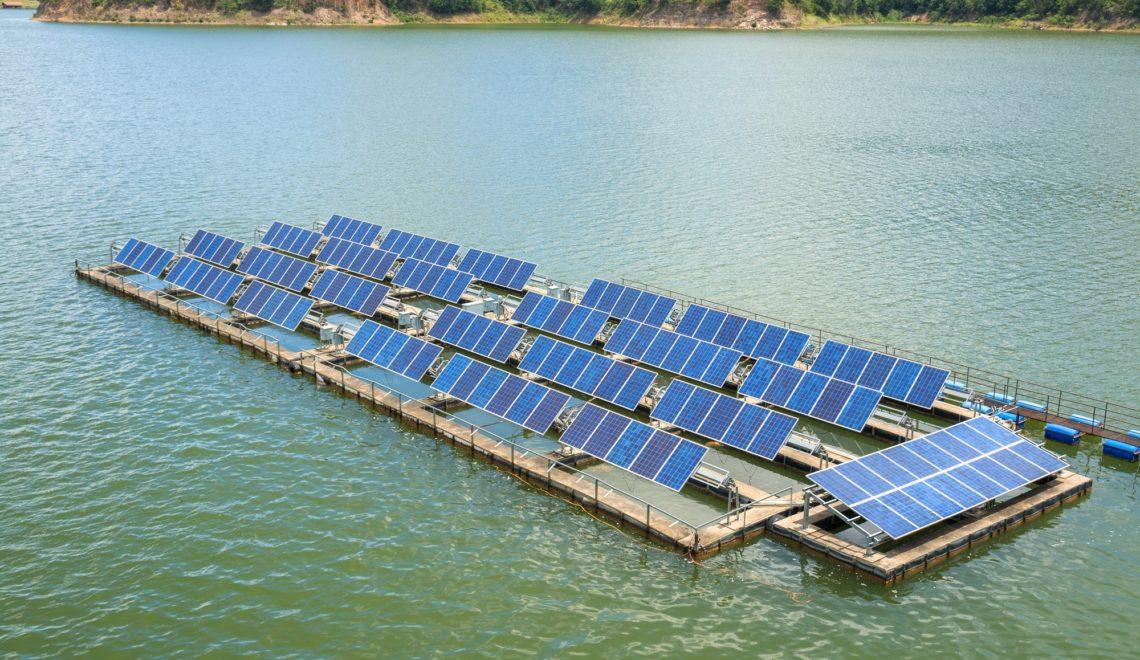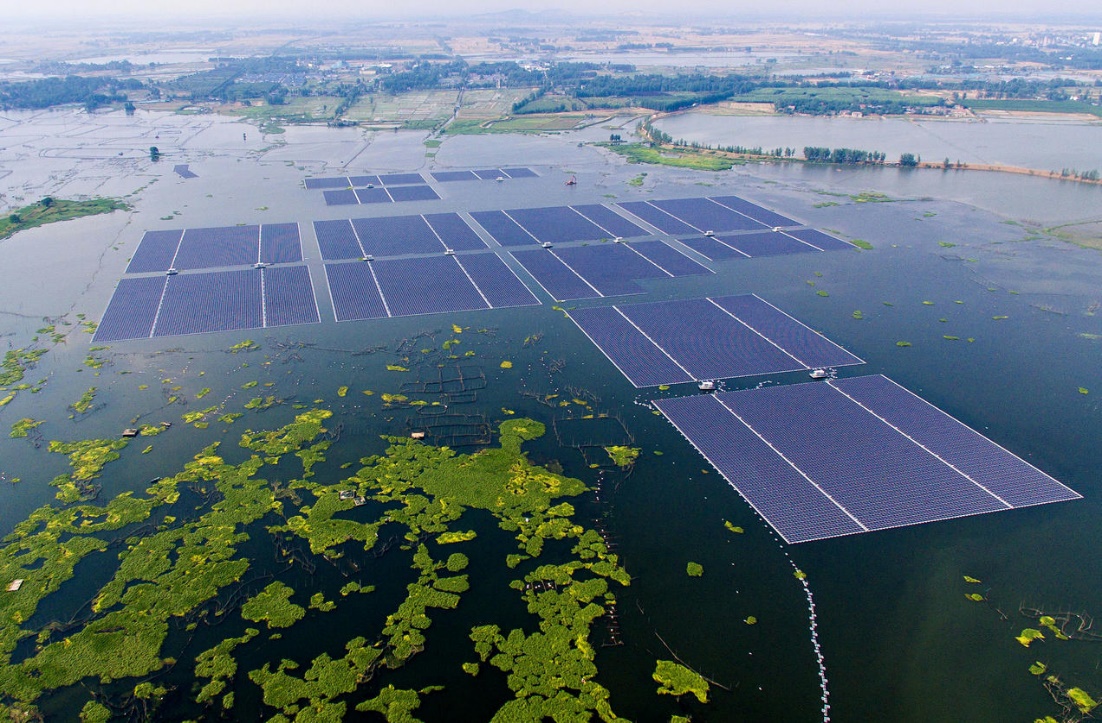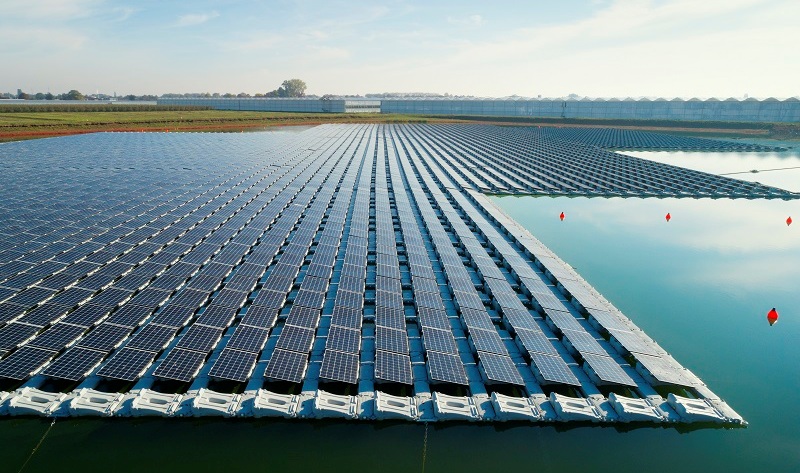Introduction
In The Pursuit Of Sustainable Energy Solutions, India Has Embraced The Concept Of Floating Solar Power Plants, A Groundbreaking Approach To Harnessing The Abundant Sunlight That Graces Its Water Bodies. This Guide Aims To Unravel The Intricacies Of Floating Solar Power Plants In India, Exploring Their Significance, Functioning, Advantages, And The Transformative Impact They Have On The Country’s Renewable Energy Landscape.
1. NTPC Floating Solar Plant Ramagundam (100 MW)
The 100 MW NTPC Floating Solar Plant at Ramagundam is an engineering marvel that combines advanced technology with eco-friendliness. This project, constructed by M/s BHEL with a budget of Rs. 423 crores, spreads over 500 acres of the reservoir and is divided into 40 blocks, each capable of producing 2.5 MW of power.
One of the most remarkable features of this project is that all the electrical equipment, including the inverter, transformer, HT panel, and SCADA, are located on floating ferro cement platforms anchored to the dead-weight concrete blocks. This arrangement not only maximizes space utilization but also reduces the evaporation rate from the water body underneath the solar modules, thereby conserving water and improving the efficiency of power generation.
By using HDPE material for the floaters and special HMPE ropes for anchoring, this project has demonstrated the use of cutting-edge technology in renewable energy. Additionally, the project will help reduce coal consumption by 1,65,000 tons and CO2 emissions by 2,10,000 tons per year.
2. NTPC Floating Solar Plant Kayamkulam (92 MW)
The National Thermal Power Corporation (NTPC) has recently set up a 92-MW floating solar power project at its Kayamkulam unit in Kerala, making it the second-largest floating solar power project of NTPC after the 100-MW plant at Ramagundam in Telangana. The floating solar system, built on a 450-acre lake area next to the NTPC’s Rajiv Gandhi Combined Cycle Power Project, consists of around 3 lakh Made in India solar PV panels floating on water.
At a cost of ₹465 crores, the project is estimated to reduce carbon emissions by 1.73 lakh tonnes every year, and could help light up around 26,000 households daily. The NTPC has around 1,000 acres of land suitable for floating solar projects and has recently commissioned a few small solar projects at the Kayamkulam site.
The Kerala State Electricity Board has signed an agreement with the NTPC for purchasing power from the floating solar station at ₹3.16 per kWh. The project has enabled NTPC to shift its focus to solar energy, after KSEB stopped drawing power from the 359-MW naphtha-fuelled RGCCPP in 2017 due to cost concerns.
3. Rihand Dam Floating Solar Power Plant (50 MW)
The Rihand Dam Floating Solar Power Plant is a significant renewable energy project in India, located on the Rihand reservoir in Uttar Pradesh. The project has a total capacity of 50 MW.
What’s unique about this project is that it’s a joint venture between the state-owned NTPC and the Uttar Pradesh New and Renewable Energy Development Agency (UPNEDA). The power generated from the project will be sold to Uttar Pradesh Power under a power purchase agreement for a period of 25 years.
The rate of $0.044kWh has been fixed for the sale of power, making it an attractive option for both the buyer and the seller. This project is expected to contribute towards meeting the state’s increasing power demand and reducing its carbon footprint.
4. Simhadri Floating Solar PV Project (25MW)
NTPC, one of India’s leading energy companies, has demonstrated its commitment to driving the development of renewable energy in the country with the completion of its 25MW Floating Solar PV Project.
This impressive project, located on the raw water reservoir of NTPC Simhadri Super Thermal Power Project, is one of the largest floating solar power projects in India and is expected to generate an annual energy yield of 55.11 million units while saving 47.5 metric tonnes of CO2 emissions per year.
What sets this project apart is NTPC’s commitment to developing the floating solar industry in India, even without a firm tie-up for off-take of power. The project was awarded to M/s BHEL in 2019 under the EPC development model, and the unique anchoring system used in the project is the first of its kind in the country.
Spread over 75 acres, this floating solar project has the power to generate electricity from more than 1 lakh solar PV modules, providing power to around 7,000 households and saving 1,364 million litres of water per annum. This sustainable energy project is a testament to NTPC’s commitment to reducing carbon emissions and providing affordable, uninterrupted electricity through environmentally friendly energy projects.
Furthermore, NTPC is also making a plan to set up a hydrogen-based micro-grid system at Simhadri on a pilot basis, further showcasing its commitment to innovation and driving the transition to a cleaner, greener energy future.
The Emergence Of Floating Solar Power Plants In India

- Overview Of Solar Power In India: As A Nation Abundantly Blessed With Sunlight, India Has Been Actively Harnessing Solar Power To Meet Its Growing Energy Demands. The Emergence Of Floating Solar Power Plants Marks A Strategic Shift, Utilizing Water Bodies For Solar Energy Generation.
- Need For Innovative Solutions: The Growing Energy Demands, Coupled With Environmental Concerns, Prompted The Exploration Of Innovative Solar Solutions. Floating Solar Power Plants Address Land Scarcity Concerns While Maximizing Solar Exposure.
Understanding Floating Solar Power Plants: How Do They Work?
- Floating Platforms: These Solar Power Plants Consist Of Photovoltaic (PV) Panels Mounted On Floating Platforms, Which Are Anchored To The Bed Of Water Bodies Such As Lakes, Reservoirs, Or Ponds. The Floating Structure Allows For Easy Adaptation To Varying Water Levels.
- Solar Panel Technology: The Solar Panels Used In Floating Solar Power Plants Employ The Same Technology As Traditional Solar Panels. They Convert Sunlight Into Electricity Using Semiconductor Materials, Typically Silicon-Based Cells.
Advantages Of Floating Solar Power Plants
- Optimal Land Use: One Of The Key Advantages Is The Efficient Use Of Water Bodies That Might Otherwise Remain Unused. Floating Solar Power Plants Make Use Of Available Water Surfaces Without Competing For Valuable Land Resources.
- Reduced Evaporation: By Covering The Water Surface, These Solar Plants Can Reduce Evaporation, Providing An Additional Ecological Benefit, Especially In Regions Facing Water Scarcity. This Dual-Purpose Use Contributes To Sustainable Water Management.
- Increased Efficiency: The Cooling Effect Of Water Enhances The Efficiency Of Solar Panels. The Lower Operating Temperatures Result In Better Energy Conversion Rates, Making Floating Solar Power Plants More Efficient Than Their Land-Based Counterparts.
Pioneering Projects: Notable Floating Solar Installations In India

- Kayakalp Floating Solar Power Plant: Located In Raipur, Chhattisgarh, The Kayakalp Floating Solar Power Plant Is One Of India’s Pioneering Projects. Floating On A Water Reservoir, It Showcases The Potential For Renewable Energy Integration In Diverse Geographical Contexts.
- Ramagundam Floating Solar Power Plant: Situated In Telangana, The Ramagundam Floating Solar Power Plant Is Among The Largest Of Its Kind In India. This Project Not Only Contributes To Clean Energy Generation But Also Demonstrates The Adaptability Of Floating Solar Technology To Industrial Settings.
Environmental Impact And Sustainability
- Eco-Friendly Energy Generation: Floating Solar Power Plants Align With India’s Commitment To Environmentally Friendly Energy Solutions. The Use Of Sunlight To Generate Electricity Produces Minimal Environmental Impact Compared To Conventional Power Generation Methods.
- Biodiversity Considerations: Proper Planning And Environmental Impact Assessments Are Crucial In Implementing Floating Solar Projects. By Considering The Impact On Local Ecosystems And Biodiversity, These Projects Can Coexist Harmoniously With The Environment.
Government Initiatives And Policies
- National Solar Mission: India’s National Solar Mission, Launched In 2010, Aims To Promote The Use Of Solar Energy Across The Country. The Inclusion Of Floating Solar Power In National Policies Reflects The Government’s Commitment To Diversifying Its Renewable Energy Portfolio.
- Financial Incentives: Various Financial Incentives, Subsidies, And Policy Frameworks Support The Development Of Floating Solar Projects. These Initiatives Encourage Both Public And Private Sector Participation, Fostering A Conducive Environment For Sustainable Energy Growth.
Technological Advancements In Floating Solar

- Floating Solar Innovations: Ongoing Research And Development Efforts Continue To Enhance The Efficiency And Durability Of Floating Solar Technologies. Innovations In Materials, Anchoring Systems, And Energy Storage Contribute To The Evolution Of These Power Plants.
- Hybrid Systems: Integrating Floating Solar With Other Renewable Energy Sources, Such As Wind Or Hydroelectric Power, Creates Hybrid Energy Systems. These Systems Maximize Energy Output And Provide A More Consistent Power Supply.
Challenges And Considerations In Floating Solar Implementation
- Water Quality And Maintenance: Maintaining Water Quality Is Essential For The Longevity Of Floating Solar Panels. Proper Water Treatment Measures And Regular Maintenance Are Necessary To Prevent Biofouling And Other Issues Associated With Water Exposure.
- Navigational Concerns: Floating Solar Installations Must Consider Navigational Routes And Potential Conflicts With Existing Water Activities. Proper Planning And Coordination With Local Authorities Address Concerns Related To Water Transportation And Recreation.
Conclusion: Navigating The Waters Of Sustainable Energy
Floating Solar Power Plants In India Represent A Transformative Approach To Sustainable Energy Generation, Tapping Into The Vast Potential Of Water Bodies Bathed In Sunlight. As These Projects Continue To Make Waves In The Country’s Energy Landscape, Understanding Their Functioning, Advantages, And The Surrounding Ecosystem Becomes Paramount. The Journey Towards A More Sustainable Future Is Buoyed By The Innovation, Commitment, And Adaptability Exemplified By Floating Solar Power In India.
